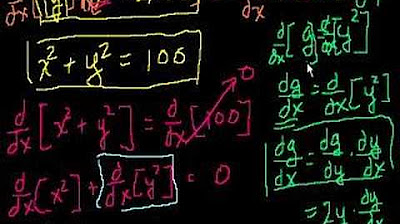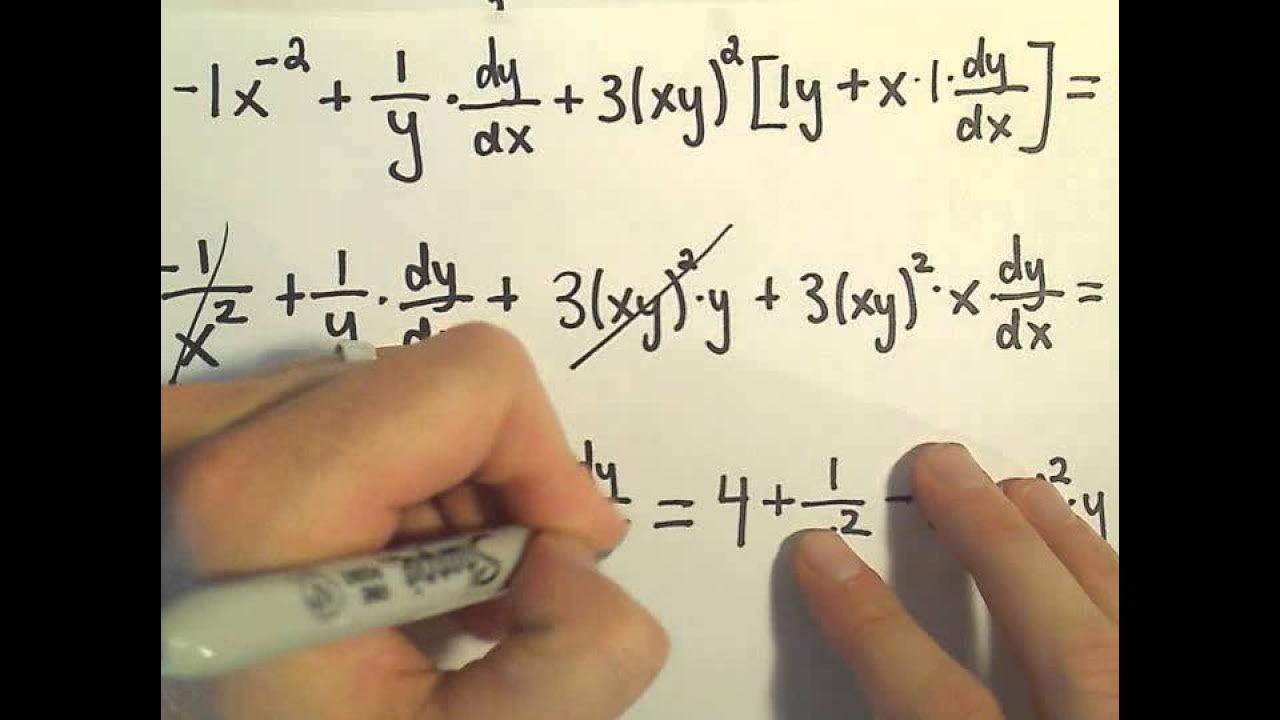Implicit Differentiation (part 2)
TLDRThe video script presents a detailed walkthrough of implicit differentiation, focusing on the process of finding the derivative of y with respect to x for the equation y^3 - xy^2 + cos(xy) = 2. The explanation involves taking derivatives on both sides of the equation, applying the chain rule and product rule, and simplifying the resulting expression to isolate dy/dx. The problem is solved step by step, with emphasis on understanding the underlying mathematical concepts.
Takeaways
- 📚 The task involves performing implicit differentiation, a technique for finding the derivative of a function when it is not explicitly defined.
- 👨🏫 The video script is a walkthrough of solving a specific implicit differentiation problem sent by a user named Akash.
- 🌟 The main equation to differentiate is y^3 - xy^2 + cos(xy) = 2.
- 🔄 The process starts by taking the derivative of both sides of the equation with respect to x.
- 📈 The derivative of y^3 with respect to x is found using the chain rule, resulting in 3y^2 * dy/dx.
- 🔢 For the term xy^2, the product rule is applied, recognizing x as an implicit function of x.
- 🌌 The derivative of cos(xy) involves the chain rule again, leading to -sin(xy) times the derivative of xy with respect to x.
- 📊 The derivative of the constant 2 is zero, as it does not change with respect to x.
- 🔍 The final expression for dy/dx is simplified by grouping and factoring terms involving dy/dx.
- 🎓 The result is an equation expressing dy/dx in terms of y, x, and their derivatives, which is the goal of implicit differentiation.
- 💡 The video emphasizes the importance of understanding the chain rule, product rule, and algebraic manipulation for solving these types of problems.
Q & A
What is the main topic of the video?
-The main topic of the video is implicit differentiation, specifically differentiating functions that are not explicitly expressed in terms of y as a function of x.
What was the first equation presented in the video?
-The first equation presented in the video is y^3 - xy^2 + cos(xy) = 2.
What is the goal of differentiating the given equation?
-The goal is to find the derivative of y with respect to x, denoted as dy/dx.
What rule was used to differentiate y^3 with respect to x?
-The chain rule was used to differentiate y^3 with respect to x, resulting in 3y^2 * dy/dx.
How was the derivative of xy^2 handled in the differentiation process?
-The product rule was applied to differentiate xy^2, resulting in x * dy/dx + 2y * x * dy/dx.
What is the derivative of the constant 2 with respect to x?
-The derivative of the constant 2 with respect to x is 0, as constants do not change with respect to x.
How was the derivative of cos(xy) with respect to x calculated?
-The chain rule was used again for the derivative of cos(xy), resulting in -sin(xy) * dy/dx.
What is the final expression for dy/dx?
-The final expression for dy/dx is (y^2 + y * sin(xy)) / (3y^2 - 2xy - x * sin(xy)).
What is the significance of the final result?
-The final result represents the derivative of y with respect to x for the given implicit function, which is crucial for understanding the rate of change of y as x varies.
What advice does the speaker give at the end of the video?
-The speaker advises the viewers to practice the problem on their own to ensure they understand the process of implicit differentiation.
Outlines
📚 Introduction to Implicit Differentiation
The paragraph begins with the speaker acknowledging a request from a user named Akash to demonstrate more implicit differentiation problems. The speaker expresses confidence in the quality of the problems provided and commits to solving them. The first problem involves a cubic function of y minus the product of x and y squared plus the cosine of the product of x and y, set equal to 2. The goal is to find the derivative of y with respect to x, denoted as dy/dx. The speaker outlines the process of implicit differentiation, which involves differentiating both sides of the equation with respect to x and applying the chain rule for functions of functions. The speaker then proceeds to differentiate each term of the equation, explaining the steps clearly and offering to slow down if needed.
🧠 Derivative Calculation and Chain Rule Application
In this paragraph, the speaker continues the process of implicit differentiation, focusing on the calculation of derivatives for each term in the equation. The speaker explains the application of the product rule for the term x times y squared and the chain rule for the cosine of the product of x and y. The speaker breaks down the steps of the chain rule, emphasizing the need to differentiate the inside function first and then multiply by the derivative of the outside function. The speaker also clarifies the process of taking the derivative of the constant 2, which is zero. The explanation includes the use of algebraic manipulation to simplify the expressions and the application of the product rule to find the derivative of the xy term. The speaker aims to provide a comprehensive understanding of the differentiation process.
📈 Final Simplified Form of the Derivative
The speaker concludes the process of implicit differentiation by simplifying the expression obtained from the previous steps. The speaker groups terms containing the derivative dy/dx and those without, then isolates the terms with dy/dx to one side of the equation to find the final form of dy/dx. The speaker emphasizes the importance of understanding the steps and encourages the user to practice the problem on their own. The final simplified expression for dy/dx is presented as y squared plus y times the sine of xy divided by the expression 3y squared minus 2xy minus x times the sine of xy. The speaker wraps up the explanation, expressing hope that the demonstration has helped the user understand implicit differentiation and invites them to continue practicing the technique.
Mindmap
Keywords
💡Implicit Differentiation
💡Derivative
💡Chain Rule
💡Product Rule
💡xy
💡Cosine Function
💡Sine Function
💡Algebraic Simplification
💡Derivative of a Constant
💡Rate of Change
💡Trigonometric Functions
Highlights
Introduction to implicit differentiation and the problems sent by Akash.
Objective to find the derivative of y with respect to x in the given equation y^3 - xy^2 + cos(xy) = 2.
Differentiation of both sides of the equation with respect to x using the chain rule.
Derivative of y^3 with respect to y and then applying the chain rule to find dy/dx.
Derivative of the product xy^2 using the product rule and its implications.
Differentiation of the constant 2 results in 0, emphasizing the properties of constants in differentiation.
Application of the chain rule to differentiate cos(xy) by considering it as a composite function.
Derivative of cos(g) with respect to g, where g is xy, and its significance in the problem.
Explanation of the chain rule in the context of the given problem, clarifying the process of differentiation.
Derivative of xy with respect to x using the product rule and its components.
Simplification of the derived equation by grouping and distributing terms involving dy/dx.
Algebraic manipulation to isolate terms with dy/dx and those without it.
Final expression for dy/dx in terms of y, x, and their derivatives.
Emphasis on the importance of understanding implicit differentiation through this example.
Encouragement for the audience to practice the problem on their own to reinforce understanding.
Acknowledgment of potential mistakes and an invitation for the audience to correct them.
Conclusion of the problem-solving session and a farewell note to the audience.
Transcripts
Browse More Related Video

Second derivatives (implicit equations): find expression | AP Calculus AB | Khan Academy

Implicit Differentiation

Implicit Differentiation for Calculus - More Examples, #1

Implicit Differentiation - Vertical and Horizontal Tangents

Implicit Differentiation for Calculus - More Examples #2

Second Derivative of Implicit Function
5.0 / 5 (0 votes)
Thanks for rating: